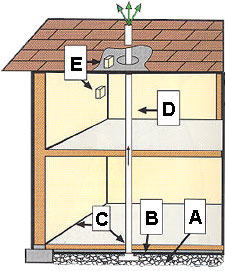- breathing home indoor radon causes nearly one hundred times more deaths each year than carbon monoxide poisoning?
- radon is the second leading cause of lung cancer behind smoking?
- some 20,000 people will die this year due to breathing too much radon without even knowing it?
Responding to this danger, EPA is joining state, local, and tribal governments, community groups, public health organizations, and industry in designating January as National Radon Action Month, to raise public awareness and promote actions reducing these risks.
As part of Radon Action Month, EPA has released public service announcements featuring Fuad Reveiz, a member of the National Association of Home Builders and former NFL Pro Bowl place-kicker.
"It's simple and cost-effective to build new homes with radon-resistant features," Reveiz says. "It makes sense to do it right from the start."
What are Radon-resistant construction techniques?
The techniques may vary for different foundations and site requirements, but the basic elements are:

- Gas Permeable Layer: This layer is placed beneath the slab or flooring system to allow the soil gas to move freely underneath the house. In many cases, the material used is a 4-inch layer of clean gravel.
- Plastic Sheeting: Plastic sheeting is placed on top of the gas permeable layer and under the slab to help prevent the soil gas from entering the home. In crawlspaces, the sheeting is placed over the crawlspace floor.
- Sealing and Caulking: All openings in the concrete foundation floor are sealed to reduce soil gas entry into the home.
- Vent Pipe: A 3- or 4-inch gas-tight or PVC pipe (commonly used for plumbing) runs from the gas permeable layer through the house to the roof to safely vent radon and other soil gases above the house.
- Junction Box: An electrical junction box is installed in case an electric venting fan is needed later.
Radon is an invisible radioactive gas that seeps into homes undetected through foundation cracks, and can reach harmful levels if trapped indoors. It travels up from underground sources of uranium in the earth's crust. EPA estimates that one in 15 homes will have a radon level of four PicoCuries per liter (pCi/L) of air or more, a level the agency considers high.
The radon threat is preventable with some simple steps. In existing homes, families can begin protecting themselves by buying an easy-to-use radon test kit to determine if a high level exists; if so, a high level might be lowered simply with a straight-forward radon venting system installed by a contractor. In new homes, builders can easily and economically include radon-resistant features during construction, and home buyers should ask for these. EPA also recommends that home buyers ask their builder to test for radon gas before they move in.
Radon preventive actions have saved an estimated 6,000 lives in the last 20 years. EPA has a goal to double that number, to 12,000 lives saved, in the next five years. All Americans can contribute to saving someone's life by testing and reducing high levels in existing homes or testing and building radon-resistant new homes.
For more information about radon, visit here or call
1-800-SOS-RADON (767-7236).
For a personal account of how radon affected a family, go here






Comments